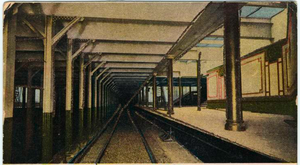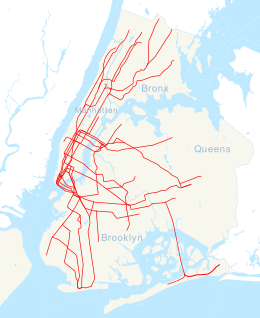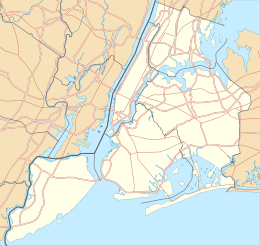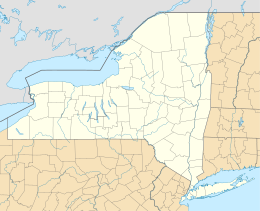railroad.wikisort.org - Station
The 18th Street station was a local station on the IRT Lexington Avenue Line of the New York City Subway. It was located at the intersection of Park Avenue South and 18th Street in Gramercy, Manhattan.
18 Street | ||||||||||||||||||||||||||||||||||||||||||||||||||||||||||||||||||||
|---|---|---|---|---|---|---|---|---|---|---|---|---|---|---|---|---|---|---|---|---|---|---|---|---|---|---|---|---|---|---|---|---|---|---|---|---|---|---|---|---|---|---|---|---|---|---|---|---|---|---|---|---|---|---|---|---|---|---|---|---|---|---|---|---|---|---|---|---|
| Former New York City Subway station | ||||||||||||||||||||||||||||||||||||||||||||||||||||||||||||||||||||
 18th Street station shortly after construction | ||||||||||||||||||||||||||||||||||||||||||||||||||||||||||||||||||||
| Station statistics | ||||||||||||||||||||||||||||||||||||||||||||||||||||||||||||||||||||
| Address | East 18th Street & Park Avenue South New York, NY | |||||||||||||||||||||||||||||||||||||||||||||||||||||||||||||||||||
| Borough | Manhattan | |||||||||||||||||||||||||||||||||||||||||||||||||||||||||||||||||||
| Locale | Gramercy | |||||||||||||||||||||||||||||||||||||||||||||||||||||||||||||||||||
| Coordinates | 40.737°N 73.989°W | |||||||||||||||||||||||||||||||||||||||||||||||||||||||||||||||||||
| Division | A (IRT)[1] | |||||||||||||||||||||||||||||||||||||||||||||||||||||||||||||||||||
| Line | IRT Lexington Avenue Line | |||||||||||||||||||||||||||||||||||||||||||||||||||||||||||||||||||
| Services | None (abandoned) | |||||||||||||||||||||||||||||||||||||||||||||||||||||||||||||||||||
| Structure | Underground | |||||||||||||||||||||||||||||||||||||||||||||||||||||||||||||||||||
| Platforms | 2 side platforms | |||||||||||||||||||||||||||||||||||||||||||||||||||||||||||||||||||
| Tracks | 4 | |||||||||||||||||||||||||||||||||||||||||||||||||||||||||||||||||||
| Other information | ||||||||||||||||||||||||||||||||||||||||||||||||||||||||||||||||||||
| Opened | October 27, 1904[2] | |||||||||||||||||||||||||||||||||||||||||||||||||||||||||||||||||||
| Closed | November 8, 1948[3] | |||||||||||||||||||||||||||||||||||||||||||||||||||||||||||||||||||
| Station succession | ||||||||||||||||||||||||||||||||||||||||||||||||||||||||||||||||||||
| Next north | 23rd Street | |||||||||||||||||||||||||||||||||||||||||||||||||||||||||||||||||||
| Next south | 14th Street–Union Square | |||||||||||||||||||||||||||||||||||||||||||||||||||||||||||||||||||
| ||||||||||||||||||||||||||||||||||||||||||||||||||||||||||||||||||||
| ||||||||||||||||||||||||||||||||||||||||||||||||||||||||||||||||||||
| ||||||||||||||||||||||||||||||||||||||||||||||||||||||||||||||||||||
The 18th Street station was constructed for the Interborough Rapid Transit Company (IRT) as part of the city's first subway line, which was approved in 1900. Construction of the line segment that includes the 18th Street station started on September 12 of the same year. The station opened on October 27, 1904, as one of the original 28 stations of the New York City Subway. The station was closed on November 8, 1948, as a result of a platform lengthening project at 23rd Street.
The 18th Street station contains two abandoned side platforms and four tracks. The station was built with tile and mosaic decorations. Many of these decorations have been covered with graffiti.
History
Construction and opening
Planning for a subway line in New York City dates to 1864.[4]: 21 However, development of what would become the city's first subway line did not start until 1894, when the New York State Legislature authorized the Rapid Transit Act.[4]: 139–140 The subway plans were drawn up by a team of engineers led by William Barclay Parsons, chief engineer of the Rapid Transit Commission. It called for a subway line from New York City Hall in lower Manhattan to the Upper West Side, where two branches would lead north into the Bronx.[5]: 3 A plan was formally adopted in 1897,[4]: 148 and all legal conflicts concerning the route alignment were resolved near the end of 1899.[4]: 161 The Rapid Transit Construction Company, organized by John B. McDonald and funded by August Belmont Jr., signed the initial Contract 1 with the Rapid Transit Commission in February 1900,[6] in which it would construct the subway and maintain a 50-year operating lease from the opening of the line.[4]: 165 In 1901, the firm of Heins & LaFarge was hired to design the underground stations.[5]: 4 Belmont incorporated the Interborough Rapid Transit Company (IRT) in April 1902 to operate the subway.[4]: 182
The 18th Street station was constructed as part of the route segment from Great Jones Street to 41st Street. Construction on this section of the line began on September 12, 1900. The section from Great Jones Street to a point 100 feet (30 m) north of 33rd Street was awarded to Holbrook, Cabot & Daly Contracting Company, while the remaining section to 41st Street was done by Ira A. Shaker.[6] By late 1903, the subway was nearly complete, but the IRT Powerhouse and the system's electrical substations were still under construction, delaying the system's opening.[4]: 186 [7] The 18th Street station opened on October 27, 1904, as one of the original 28 stations of the New York City Subway from City Hall to 145th Street on the Broadway–Seventh Avenue Line.[2][4]: 186
Service changes and closure
After the first subway line was completed in 1908,[8] the station was served by local trains along both the West Side (now the Broadway–Seventh Avenue Line to Van Cortlandt Park–242nd Street) and East Side (now the Lenox Avenue Line). West Side local trains had their southern terminus at City Hall during rush hours and South Ferry at other times, and had their northern terminus at 242nd Street. East Side local trains ran from City Hall to Lenox Avenue (145th Street).[9] In 1918, the Lexington Avenue Line opened north of Grand Central–42nd Street, thereby dividing the original line into an "H"-shaped system. All local trains were sent via the Lexington Avenue Line, running along the Pelham Line in the Bronx.[10]
To address overcrowding, in 1909, the New York Public Service Commission proposed lengthening platforms at stations along the original IRT subway.[11]: 168 As part of a modification to the IRT's construction contracts, made on January 18, 1910, the company was to lengthen station platforms to accommodate ten-car express and six-car local trains. In addition to $1.5 million (equivalent to $43.6 million in 2021) spent on platform lengthening, $500,000 (equivalent to $14,541,000 in 2021) was spent on building additional entrances and exits. It was anticipated that these improvements would increase capacity by 25 percent.[12]: 15 Platforms at local stations, such as the 18th Street station, were lengthened by between 20 to 30 feet (6.1 to 9.1 m). Both platforms were extended to the north and south.[12]: 108 Six-car local trains began operating in October 1910.[11]: 168
The closing of this station was proposed as early as 1928.[13] The city government took over the IRT's operations on June 12, 1940.[14][15] The station closed on November 8, 1948. The platforms at 23rd Street had been lengthened, with entrances at 22nd Street, and the 18th Street station was close to the 14th Street–Union Square station.[3]
Station layout
| G | Street level | |
| P Platform level |
Side platform, not in service | |
| Northbound local | ← | |
| Northbound express | ← | |
| Southbound express | | |
| Southbound local | | |
| Side platform, not in service | ||

Like other local stations, 18th Street has four tracks and two abandoned side platforms. The two local tracks, which formerly served the station, are used by the 6 train at all times, <6> trains during weekdays in the peak direction, and the 4 train during late nights. The two express tracks are used by the 4 and 5 trains during daytime hours.[16] The platforms were 200 feet (61 m) long, as at other local stations on the original IRT.[5]: 4 [17]: 8
As with other stations built as part of the original IRT, the station was constructed using a cut-and-cover method.[18]: 237 The tunnel is covered by a "U"-shaped trough that contains utility pipes and wires. The bottom of this trough contains a foundation of concrete no less than 4 inches (100 mm) thick.[17]: 9 Each former platform consists of 3-inch-thick (7.6 cm) concrete slabs, beneath which are drainage basins. The former platforms contain circular, cast-iron Doric-style columns spaced every 15 feet (4.6 m). Additional columns between the tracks, spaced every 5 feet (1.5 m), support the jack-arched concrete station roofs.[5]: 4 [17]: 9 There is a 1-inch (25 mm) gap between the trough wall and the platform walls, which are made of 4-inch (100 mm)-thick brick covered over by a tiled finish.[17]: 9
The decorative scheme consisted of blue/green tile tablets, buff and violet tile bands, a violet faience cornice, and green faience plaques.[17]: 34 The mosaic tiles at all original IRT stations were manufactured by the American Encaustic Tile Company, which subcontracted the installations at each station.[17]: 31 The decorative work was performed by tile contractor Manhattan Glass Tile Company and faience contractor Grueby Faience Company.[17]: 34 The 18th Street station is fairly well preserved, with the exception of some litter and graffiti.
See also
- Worth Street (IRT Lexington Avenue Line)
- 91st Street (IRT Broadway–Seventh Avenue Line)
References
- "Glossary". Second Avenue Subway Supplemental Draft Environmental Impact Statement (SDEIS) (PDF). Vol. 1. Metropolitan Transportation Authority. March 4, 2003. pp. 1–2. Archived from the original (PDF) on February 26, 2021. Retrieved January 1, 2021.
- "Our Subway Open: 150,000 Try It; Mayor McClellan Runs the First Official Train". The New York Times. October 28, 1904. p. 1. ISSN 0362-4331. Archived from the original on December 13, 2021. Retrieved April 21, 2020.
- "IRT Station To Be Closed; East Side Subway Trains to End Stops at 18th Street". The New York Times. November 6, 1948. p. 29. ISSN 0362-4331. Archived from the original on July 23, 2018. Retrieved April 17, 2010.
- Walker, James Blaine (1918). Fifty Years of Rapid Transit — 1864 to 1917. New York, N.Y.: Law Printing. Retrieved November 6, 2016.
- "Interborough Rapid Transit System, Underground Interior" (PDF). New York City Landmarks Preservation Commission. October 23, 1979. Archived (PDF) from the original on September 21, 2020. Retrieved November 19, 2019.
- Report of the Board of Rapid Transit Railroad Commissioners for the City of New York For The Year Ending December 31, 1904 Accompanied By Reports of the Chief Engineer and of the Auditor. Board of Rapid Transit Railroad Commissioners. 1905. pp. 229–236.
- "First of Subway Tests; West Side Experimental Trains to be Run by Jan. 1 Broadway Tunnel Tracks Laid, Except on Three Little Sections, to 104th Street -- Power House Delays". The New York Times. November 14, 1903. ISSN 0362-4331. Retrieved May 10, 2022.
- "Our First Subway Completed At Last — Opening of the Van Cortlandt Extension Finishes System Begun in 1900 — The Job Cost $60,000,000 — A Twenty-Mile Ride from Brooklyn to 242d Street for a Nickel Is Possible Now". The New York Times. August 2, 1908. p. 10. Archived from the original on December 23, 2021. Retrieved November 6, 2016.
- Herries, William (1916). Brooklyn Daily Eagle Almanac. Brooklyn Daily Eagle. p. 119. Archived from the original on May 11, 2021. Retrieved December 24, 2020.
- "Open New Subway Lines to Traffic; Called a Triumph — Great H System Put in Operation Marks an Era in Railroad Construction — No Hitch in the Plans — But Public Gropes Blindly to Find the Way in Maze of New Stations — Thousands Go Astray — Leaders in City's Life Hail Accomplishment of Great Task at Meeting at the Astor" (PDF). The New York Times. August 2, 1918. p. 1. Archived (PDF) from the original on February 21, 2021. Retrieved November 6, 2016.
- Hood, Clifton (1978). "The Impact of the IRT in New York City" (PDF). Historic American Engineering Record. pp. 146–207 (PDF pp. 147–208)
 This article incorporates text from this source, which is in the public domain.. Archived (PDF) from the original on January 17, 2021. Retrieved December 20, 2020.
This article incorporates text from this source, which is in the public domain.. Archived (PDF) from the original on January 17, 2021. Retrieved December 20, 2020. - Report of the Public Service Commission for the First District of the State of New York For The Year Ending December 31, 1910. Public Service Commission. 1911. Archived from the original on January 20, 2021. Retrieved January 7, 2021.
- Proceedings of the Board of Transportation of the City of New York. New York Board of Transportation. 1928. Archived from the original on May 4, 2022. Retrieved March 2, 2021.
- "City Transit Unity Is Now a Reality; Title to I.R.T. Lines Passes to Municipality, Ending 19-Year Campaign". The New York Times. June 13, 1940. ISSN 0362-4331. Archived from the original on January 7, 2022. Retrieved May 14, 2022.
- "Transit Unification Completed As City Takes Over I. R. T. Lines: Systems Come Under Single Control After Efforts Begun in 1921; Mayor Is Jubilant at City Hall Ceremony Recalling 1904 Celebration". New York Herald Tribune. June 13, 1940. p. 25. ProQuest 1248134780.
- Dougherty, Peter (2006) [2002]. Tracks of the New York City Subway 2006 (3rd ed.). Dougherty. OCLC 49777633 – via Google Books.
- Framberger, David J. (1978). "Architectural Designs for New York's First Subway" (PDF). Historic American Engineering Record. pp. 1–46 (PDF pp. 367–412)
 This article incorporates text from this source, which is in the public domain.. Archived (PDF) from the original on January 17, 2021. Retrieved December 20, 2020.
This article incorporates text from this source, which is in the public domain.. Archived (PDF) from the original on January 17, 2021. Retrieved December 20, 2020. - Scott, Charles (1978). "Design and Construction of the IRT: Civil Engineering" (PDF). Historic American Engineering Record. pp. 208–282 (PDF pp. 209–283)
 This article incorporates text from this source, which is in the public domain.. Archived (PDF) from the original on January 17, 2021. Retrieved December 20, 2020.
This article incorporates text from this source, which is in the public domain.. Archived (PDF) from the original on January 17, 2021. Retrieved December 20, 2020.
External links
| Wikimedia Commons has media related to 18th Street (IRT Lexington Avenue Line). |
- nycsubway.org – IRT East Side Line: 18th Street
- Abandoned Stations – 18 Street
- Forgotten NY – Original 28 – NYC's First 28 Subway Stations
- Forgotten NY: Subways and Trains – Dead at 18
На других языках
- [en] 18th Street station (IRT Lexington Avenue Line)
[ru] 18-я улица (линия Лексингтон-авеню, Ай-ар-ти)
18-я улица (англ. 18th Street) — бывшая станция Нью-Йоркского метро, расположенная на линии Лексингтон-авеню. Она представлена двумя боковыми платформами, обслуживающими два локальных пути. С 8 ноября 1948 года станция закрыта.Другой контент может иметь иную лицензию. Перед использованием материалов сайта WikiSort.org внимательно изучите правила лицензирования конкретных элементов наполнения сайта.
WikiSort.org - проект по пересортировке и дополнению контента Википедии




